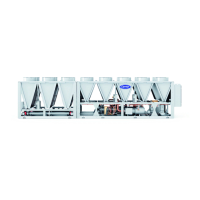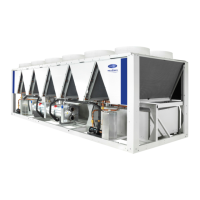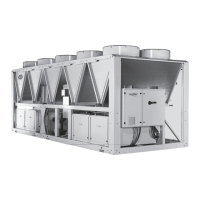39
Switch Controlled
— If using 2 or 3-step demand limit con-
trol, an energy management module must be installed. One-
step demand limit control does not require the energy manage-
ment module. To configure demand limit for switch control,
three parameters for 1-step switch control must be configured.
For 2 or 3-step control, additional set point parameters must be
configured. The parameters are: the type of Demand Limit Se-
lection, the setting for Switch Limit Setpoint 1, the setting for
Switch Limit Setpoint 2 (if required) and the setting for Switch
Limit Setpoint 3 (if required).
To configure this option with the Touch Pilot™ display:
In the following example, 2-step demand limit based on
capacity is desired with the first switch closure limiting the
capacity to 60%. The second switch closure is to limit the ca-
pacity to 40%. Demand Limit Switch 1 is 60% and Demand
Limit Switch 2 is 40%. Since no third-step demand limit is re-
quired, Switch Limit Setpoint 3 is set at 0%.
EXTERNALLY POWERED (4 to 20 mA) DEMAND
LIMIT — The energy management module is required for 4 to
20 mA demand limit control. An externally powered 4 to 20 mA
signal must be connected to TB6-1 and TB6-2. Typically the 4 to
20mA signal is provided by an active outdoor sensor connected
to this input. This signal is read by a transducer type (0 to 5 vdc)
on the EMM board via a field-installed 0.5 W 250-ohm resistor.
Externally Powered (4 to 20 mA) Current Based Demand
Limit — To configure demand limit for 4 to 20 mA control
based on unit capacity, one parameter must be configured.
The parameter is Demand Limit Type Select. The value of
the capacity limit will vary linearly for 0% to 100% based
on the input signal where 4 mA is 100% and 20 mA is 0%
of total unit capacity.
To configure this option with the Touch Pilot display:
In the example in Fig. 36, a 4 mA signal is Demand
Limit 100% and a 20 mA Demand Limit signal is 0%. The
4 to 20 mA signal is connected to TB6-1 and TB6-2. The
demand limit is a linear interpolation between the two val-
ues entered. If the machine receives a 12 mA signal, the
machine controls will limit the capacity to 50%.
DISPLAY NAME PATH VALUE
Demand Limit
Type Select
Main Menu
Configuration Menu
General Configuration
1 (Switch)
Low = 0
Default = 0 (None)
High = 4
Switch Limit
Setpoint 1
Main Menu
Setpoint Table
Low = 0%
Default = 100%
High = 100%
Switch Limit
Setpoint 2
Main Menu
Setpoint Table
Low = 0%
Default = 100%
High = 100%
(Not required
for 1-Step Control)
Switch Limit
Setpoint 3
Main Menu
Setpoint Table
Low = 0%
Default = 100%
High = 100%
(Not required for 1 or
2-Step Control)
DISPLAY NAME VALUE
Demand Limit Type Select 1
Switch Limit Setpoint 1 60%
Switch Limit Setpoint 2 40%
Switch Limit Setpoint 3 0%
CAUTION
Care should be taken when interfacing with other control
systems due to possible power supply differences such as a
full wave bridge versus a half wave rectification. Connec-
tion of control devices with different power supplies may
result in permanent damage. Touch Pilot controls incorpo-
rate power supplies with half wave rectification. A signal
isolation device should be utilized if the signal generator
incorporates a full wave bridge rectifier.
DISPLAY NAME PATH VALUE
Demand Limit
Type Select
Main Menu
Configuration Menu
General Configuration
2 (4-20mA Control)
(Default = 0 [None])
0
10
20
30
40
50
60
70
80
90
100
12 14 16 18
20
mA Demand Limit Signal
% Demand Limit
0
2
4 6
8 10
mA for Demand Limit = 100%
(lim_mx)
mA for Demand Limit = 0%
(lim_ze)
a30-5883
Fig. 36 — Example: 4 to 20 mA Demand Limit

